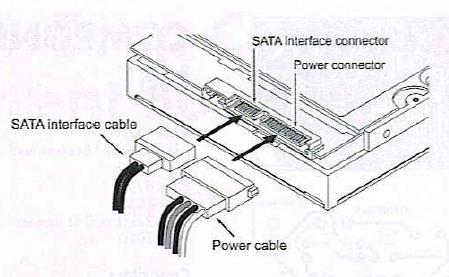

Project Solutions
SATA
Published:2011/8/15 1:34:00 Author:Amy From:SeekIC
Karel Walraven 
There is a new standard these days for connecting hard disks and DVD drives: SATA. You may already have noticed that new PCs don’t contain the wide 40- or 80-pin ribbon cables any more, but the hard disk is connected with a slender 7- way cable. Even the corresponding power supply connector is different with a SATA drive and now has 15 connections instead of 4. This is clearly illustrated in the drawing: The large connector provides power and the small connector is the data connection. The power supply connector provides 12, 5 and 3.3 V and two ground connections.
SATA means Serial ATA. ATA is the connection standard that at present has been the most common for hard disks, CD and DVD drives. At the time of writing the ATA100 bus with a data transfer speed of 100 Mbyte/s is the most widespread. A number of manufacturers use the slightly faster ATA133 bus. That is pretty much the end of the line; it has not been possible for the industry to increase the speed even further using simple means. In order to increase the speed of the interface between motherboard and HDD, a serial connection was selected. At first glance this appears to be a perplexing choice! The parallel ATA bus operates with 16 bits simultaneously; the serial bus therefore has to be at least 16 times faster to obtain the same equivalent speed. That is why SATA operates at a clock speed of 1500 MHz and reaches a data transfer speed of 150 MByte/s; versions with 3 GHz and 6 GHz clock speed are planned.
The industry made this choice because, in the end, it is cheaper to have a solution with one data channel at very high speed than trying to increase the speed of all 33 signals in the ATA connection. The data connection has a balanced outgoing and a balanced return connection, plus three ground connections. The signal amplitude is not 5 volts any more, but only 0.25 volts. The symmetrical connection and the small signal amplitude together result in a fast, low interference and energy efficient connection. In addition, the cable is allowed to be much longer: 1 m instead of 45 cm with ATA.
Another big difference is that each device (HDD, DVD) has its own cable and connection to the motherboard. With the current ATA standard two devices can share the same cable. As a consequence various jumpers (master, slave) disappear and the interface can (in principle) always operate at maximum speed.
Additionally, the contacts in the connectors are of different length, so that hot-plugging (connecting or disconnection without switching the power off) becomes possible. The expectation is that this interface will satisfy the requirements for the next ten years.
Reprinted Url Of This Article: http://www.seekic.com/blog/project_solutions/2011/08/15/SATA.html
Print this Page | Comments | Reading(653)
Article Categories
New published articles
· Imagination works with TSMC to develop FinFET process
Author:Ecco Reading(33516)
· XMOS pushes event-driven MCUs with lower price
Author:Ecco Reading(3534)
· Intel brings upgraded 32-nm SoC for smartphones
Author:Ecco Reading(3250)
· Micron pushes TLC 128-Gbit NAND flash
Author:Ecco Reading(3816)
· Intel will stop supplying desktop motherboards
Author:Ecco Reading(5341)
· Processor market was expected to regain strength in 2013
Author:Ecco Reading(3318)
· It was reported that TSMC sales fall steeply
Author:Ecco Reading(3474)
· Cisco, NXP work with auto wireless startup
Author:Ecco Reading(3620)
· Micron was impacted by manufacturing glitch
Author:Ecco Reading(4017)
· China can make 22-nm transistor by themselves
Author:Ecco Reading(3819)
· Chip market rebound is coming, according to survey
Author:Ecco Reading(3760)
· Sony, Toshiba will spend more on chips, iSuppli reports
Author:Ecco Reading(3790)
· Qualcomm becomes the 13th company to join NFC Forum board
Author:Ecco Reading(6103)
· TSMC increases building work for FinFET fab
Author:Ecco Reading(3778)
· TI plans to cut 1,700 jobs in OMAP shift
Author:Ecco Reading(4587)